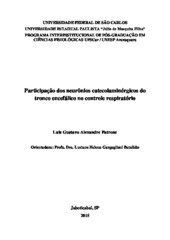Participação dos neurônios catecolaminérgicos do tronco encefálico no controle respiratório

Visualizar/
Data
2015-10-02Autor
Patrone, Luis Gustavo Alexandre
Metadata
Mostrar registro completoResumo
It is well know that the respiratory network, undergoes significant development
in the postnatal period. Among various processes, the maturing of the catecholaminergic
(CA) system shows to be an important factor in the control and modulation of
respiratory rhythmogenesis. Studies have also shown that these neurons are widely
distributed in the Central Nervous System (CNS), including the A1/C1, A2/C2, C3, A5,
A6 and A7 regions, having numerous projections to many regions of the brain.
However, the development of respiratory network as well as its effect on the control of
ventilation, is not yet fully understood. Thus, understanding the participation of CA
neurons in the respiratory control during postnatal development is of most importance
for a better understanding of some clinical disorders including Rett Syndrome, Sudden
Infant Death Syndrome (SIDS) and Central Congenital Hypoventilation Syndrome
(CCHS). Therefore, this study aimed to investigate the involvement of CA neurons in
the brainstem on respiratory control in normoxic normocapnic, hypercapnic and
hypoxic conditions during the postnatal period of male and female neonatal rats,
through chemical injury with conjugated saporin anti-dopamine beta-hydroxylase
(DBH-SAP). Thus, DBH-SAP (42 ng/100 nL – 1L), saporin (SAP – 1L) or
phosphate buffered solution vehicle (PBS, 0.01M, pH 7.4 – 1L) were injected into the
4th ventricle in male and female neonates Wistar rats P0-1. Pulmonary ventilation ( EV )
was recorded in unanesthetized neonates (P7-8) by pressure plethysmography during
normocapnia, hypercapnia (7% CO2) and hypoxia (10% O2) at 10 and 20 min after the
start of exposure. Our data demonstrate that lesion of brainstem CA neurons increased
ventilation in males and females newborn under room air conditions. In addition, the
ventilatory response to hypercapnia was significantly reduced in male (57%) and female
(55%) lesioned neonatal rats (Male – SAP group: 212.8 ± 7.0; PBS group: 203.9 ± 10.3;
lesioned group: 151.1 ± 7.4; P < 0,001; Female – SAP group: 218.2 ± 10.4; PBS group:
200.0 ± 6.4; lesioned group: 154.0 ± 9.6; P < 0,001; all values relative to % of baseline).
Also, a similar reduction was observed in the hypoxic condition (Male – SAP group:
185.2 ± 15.3; PBS group: 167.4 ± 5.0; lesioned group: 110.8 ± 9.2; P < 0,001; Female –
SAP group: 197.3 ± 11.8; PBS group: 179.5 ± 13.7; lesioned: 129.4 ± 5.9; P < 0,001; all
values relative to % of baseline). Additionally, the values for metabolic rate of control
and lesioned groups, both males and females, did not differ significantly, whether in
normoxic normocapnic, hypercapnic or hypoxic conditions. These results suggest that
brainstem CA neurons exert a tonic inhibitory role in neonatal ventilation and promote
an important excitatory modulation in CO2 and O2 chemosensitivity in unanesthetized
males and females neonatal rats (P7-8).